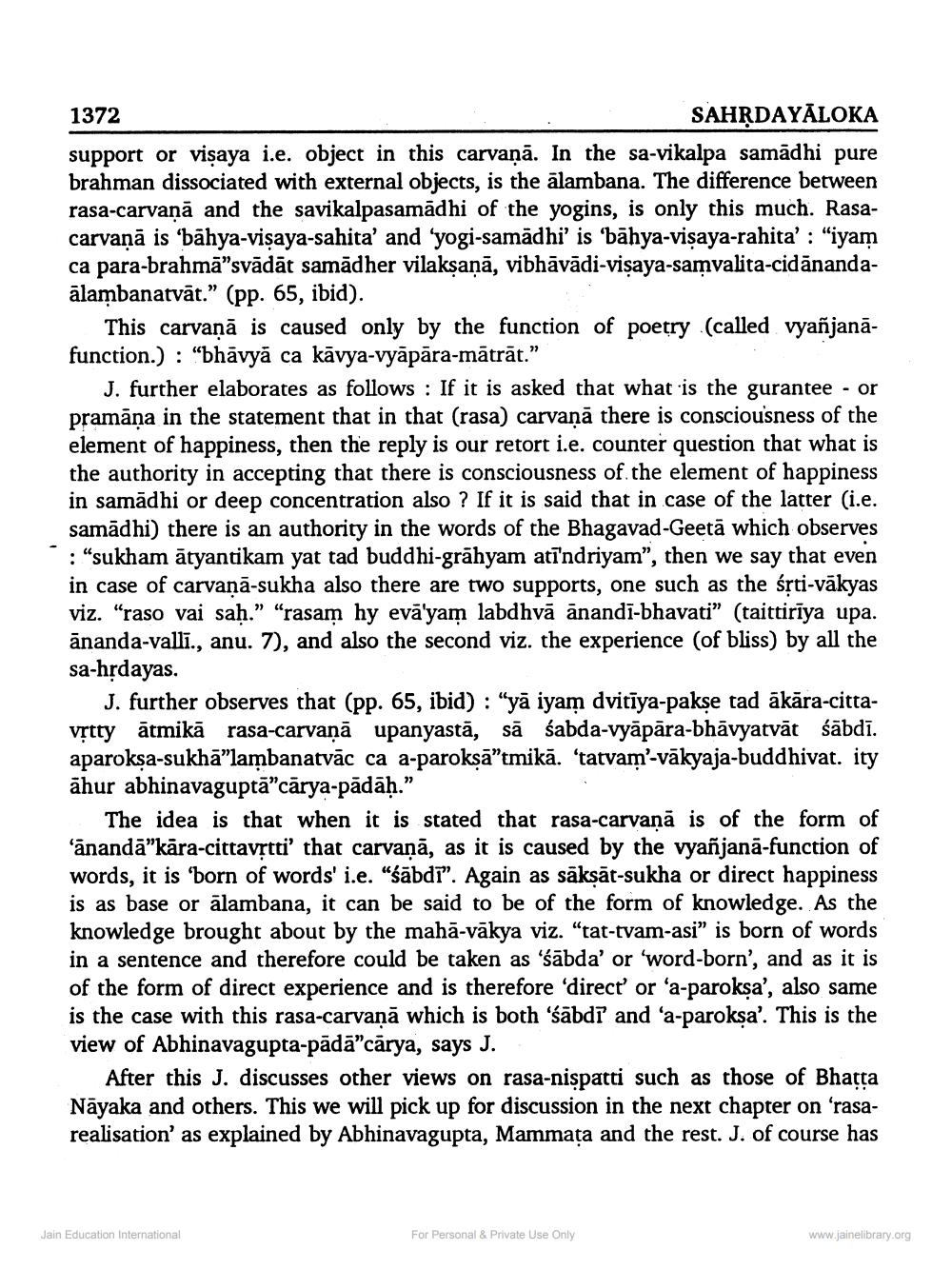________________
1372
SAHRDAYĀLOKA support or visaya i.e. object in this carvaņā. In the sa-vikalpa samādhi pure brahman dissociated with external objects, is the ālambana. The difference between rasa-carvaņā and the savikalpasamādhi of the yogins, is only this much. Rasacarvanā is 'bāhya-visaya-sahita' and 'yogi-samadhi' is 'bāhya-visaya-rahita' : "iyam ca para-brahmā"svādāt samādher vilaksanā, vibhāvādi-visaya-samvalita-cidānandaālambanatvāt.” (pp. 65, ibid).
This carvaņā is caused only by the function of poetry (called vyañjanāfunction.) : "bhāvā ca kāvya-vyāpāra-mātrāt."
J. further elaborates as follows: If it is asked that what is the gurantee - or pramāņa in the statement that in that (rasa) carvanā there is consciousness of the element of happiness, then the reply is our retort i.e. counter question that what is the authority in accepting that there is consciousness of the element of happiness in samādhi or deep concentration also ? If it is said that in case of the latter (i.e. samadhi) there is an authority in the words of the Bhagavad-Geetā which observes : "sukham ātyantikam yat tad buddhi-grāhyam ati'ndriyam”, then we say that even in case of carvaņā-sukha also there are two supports, one such as the sști-vākyas viz. "raso vai sah." "rasam hy eva'yam labdhvā anandi-bhavati" (taittiriya upa. ānanda-vallī., anu. 7), and also the second viz. the experience (of bliss) by all the sa-hțdayas.
J. further observes that (pp. 65, ibid) : "yā iyam dvitīya-pakse tad ākāra-cittavstry atmikā rasa-carvanā upanyastā, sāśabda-vyāpāra-bhāvyatvāt śābdī. aparoksa-sukhā"lambanatvāc ca a-paroksā"tmikā. 'tarvam'-vākyaja-buddhivat. ity āhur abhinavaguptā"cārya-pādāḥ.”
The idea is that when it is stated that rasa-carvanā is of the form of 'ānandā”kāra-cittavṛtti' that carvanā, as it is caused by the vyañjanā-function of words, it is 'born of words' i.e. "śābdi”. Again as sāksāt-sukha or direct happiness is as base or ālambana, it can be said to be of the form of knowledge. As the knowledge brought about by the mahā-vākya viz. "tat-tvam-asi” is born of words in a sentence and therefore could be taken as 'śābda' or 'word-born', and as it is of the form of direct experience and is therefore 'direct' or 'a-paroksa', also same is the case with this rasa-carvan, which is both 'sabdi and 'a-paroksa'. This is the view of Abhinavagupta-pādā"cārya, says J.
After this J. discusses other views on rasa-nispatti such as those of Bhatta Nayaka and others. This we will pick up for discussion in the next chapter on 'rasarealisation' as explained by Abhinavagupta, Mammata and the rest. J. of course has
Jain Education International
For Personal & Private Use Only
www.jainelibrary.org




